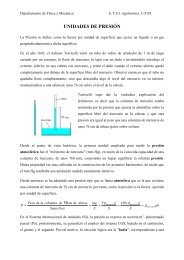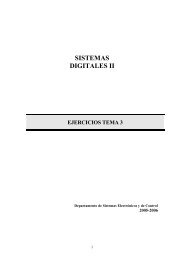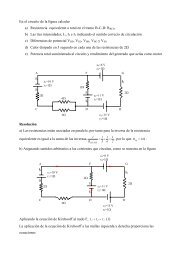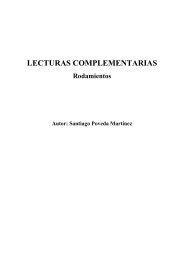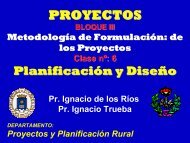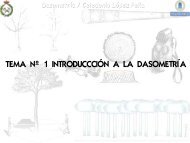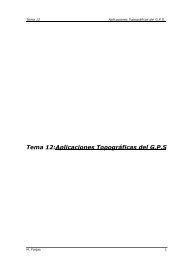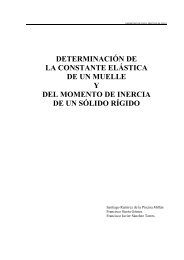Topic 11.the perfume and cosmetic sector - OCW UPM
Topic 11.the perfume and cosmetic sector - OCW UPM
Topic 11.the perfume and cosmetic sector - OCW UPM
Create successful ePaper yourself
Turn your PDF publications into a flip-book with our unique Google optimized e-Paper software.
<strong>Topic</strong> 11. The <strong>perfume</strong> <strong>and</strong> <strong>cosmetic</strong> <strong>sector</strong>s<br />
11.1 The <strong>perfume</strong> <strong>and</strong> <strong>cosmetic</strong> <strong>sector</strong>s.<br />
11.2 The <strong>cosmetic</strong> industry. The <strong>perfume</strong> <strong>sector</strong><br />
11.3 Refernces<br />
11.1. The <strong>perfume</strong> <strong>and</strong> <strong>cosmetic</strong> <strong>sector</strong>s<br />
Plants generate a considerable amount of antioxidants, preservatives, <strong>and</strong> synthetic colours.<br />
There is much dem<strong>and</strong> for these both in the food industry (as we have seen before) <strong>and</strong> in the<br />
<strong>cosmetic</strong>s industry. The <strong>perfume</strong> <strong>sector</strong> also uses important quantities of aromatic plants.<br />
We can define phyto-<strong>cosmetic</strong>s as the use of the active ingredients of plants for the care <strong>and</strong><br />
appearance of skin <strong>and</strong> hair.<br />
The use of different plants is determined by their physiological activity, which varies from plant<br />
to plant, so we can find a plant for nearly all our aesthetic needs.<br />
The dermatological properties of plants are many <strong>and</strong> varied: tonics, astringents, antiinflammatory,<br />
antiseptics, anti-scarring, cleansers, moisturisers, relaxants, emulsifiers,<br />
decongestant, refreshing, etc…<br />
There is also a wide range of formats of <strong>cosmetic</strong> preparations. We can find preparations of<br />
plant extracts in creams, emulsions, lotions, gels, oils, soaps, deodorants, etc… <strong>cosmetic</strong>s<br />
include the following type of products:<br />
- essential oils<br />
- <strong>perfume</strong>s <strong>and</strong> colognes<br />
- beauty treatment, make-up, skin treatment<br />
- sun-block <strong>and</strong> tanning preparations<br />
- products for manicure <strong>and</strong> pedicure<br />
- products for hair<br />
- dental <strong>and</strong> mouth hygiene products<br />
- products for shaving <strong>and</strong> aftershaves<br />
- body deodorants<br />
- bath products<br />
- depilatory products<br />
- other preparations<br />
Spices used.<br />
We are going to see some of the regulations edited by AENOR in December 2006 applied to<br />
raw materials for use in <strong>cosmetic</strong>s. They also refer to the vegetable extracts used in the<br />
manufacture of <strong>cosmetic</strong> products.<br />
- hydroglicolic extract of camomile (Chamomilla recutita L. Rauschert).<br />
- hydroglicolic extract of calendula (Calendula officinalis L).<br />
- hydroglicolic extract of rosemary (Rosmarinus officinalis L).<br />
- hydroglicolic extract of ivy (Hedera helix L).<br />
- hydroglicolic extract of green tea (Camellia sinesis L).<br />
- hydroglicolic extract of butcher´s broom (Ruscus aculeatus L).<br />
- hydroglicolic extract of oats (Avena sativa L).<br />
- hydroglicolic extract of aloe (Aloe vera L).<br />
- hydroglicolic extract of Indian chestnut (Aesculus hippocastanum L).
Other frequently used plants include:<br />
• Soya. A Chinese plant known for over 5,000 years. It has been recovered by <strong>cosmetic</strong><br />
laboratories because of its anti-ageing effects. It is rich in isoflavones.<br />
• Green tea. An antioxidant against free radicals. Recently, white tea has also been<br />
incorporated into the <strong>cosmetic</strong>s industry as it is thought to be more effective against free<br />
radicals.<br />
• Botanical extracts of Gingko biloba, ginseng, lavender, <strong>and</strong> aloe vera.<br />
• Camomile, which is used to make creams for sensitive skins.<br />
11.2. The <strong>cosmetic</strong> industry. The <strong>perfume</strong> <strong>sector</strong><br />
A A brief history of <strong>perfume</strong>.<br />
To find the origins of <strong>perfume</strong> we must travel back to Ancient Egypt. Incense (the word is of<br />
Latin origin <strong>and</strong> means “through smoke”) <strong>and</strong> myrrh were the basic ingredients used by the<br />
Egyptians to aromatise ceremonies, healing rituals, but also as a beauty complement for<br />
women. Furthermore, they had a complete process for the preparation of <strong>perfume</strong>s which<br />
consisted in impregnating rose leaves with oil to preserve their fragrance. They would also<br />
macerate aromatic plants in oil <strong>and</strong> then drain the oil onto a cloth.<br />
Later, the Greeks inherited these techniques <strong>and</strong> proceeded to improve them. The Romans<br />
imported raw materials such as myrrh <strong>and</strong> incense from Arabia <strong>and</strong> brought other substances<br />
from India.<br />
The fall of the Roman Empire brought about a decline in use of <strong>perfume</strong>s in the West. The<br />
custom lived on only in Arabia, where plant distillation techniques were developed. Baghdad<br />
became the city of fragrances. Other ingredients were discovered such as musk, which they<br />
mixed into the mortar used to build palaces <strong>and</strong> mosques.<br />
During the Middle Ages, the Crusader period saw a rise in commerce <strong>and</strong> trade between East<br />
<strong>and</strong> West <strong>and</strong> <strong>perfume</strong> was rediscovered. However, its general use did not come until the XVI<br />
century when Catalina de Medici imposed the <strong>perfume</strong> fashion in Paris.<br />
Later on, the Industrial Revolution saw large-scale commercialisation of <strong>perfume</strong>. Perfumiers<br />
specialised in chemistry so as to develop better products, <strong>and</strong> <strong>perfume</strong>s stopped being a<br />
fashion to become a basic requisite for the beauty criteria of the times.<br />
At the beginning of the XX century, <strong>perfume</strong>s were given away in clothes shops, but gradually<br />
they began to be sold until the first exclusive <strong>perfume</strong> companies appeared.<br />
With time, better techniques developed, <strong>and</strong> new ingredients for the making of <strong>perfume</strong>s were<br />
discovered. Nowadays, it is an important industry with millions of dollars in turnover <strong>and</strong> which<br />
designers depend on more even than on clothes.<br />
B The structure of <strong>perfume</strong>s (the pyramid system).<br />
For a long time, <strong>perfume</strong>s were thought to be evolving. But their fragrance <strong>and</strong> intensity were<br />
only due to evaporation, by this we mean volatility, <strong>and</strong> therefore to their gradual wearing off.<br />
The XX century saw the start of <strong>perfume</strong> preparation using several fragrances. The first person<br />
to introduce this system of <strong>perfume</strong> preparation was André Guerlain in 1899. From then<br />
onwards, a system known as the “pyramid” or “three layer system” was generally used. This<br />
structure divides a <strong>perfume</strong>’s fragrances into three types: high, medium, <strong>and</strong> low.<br />
High note: this corresponds to fragrances which are quicker to evaporate because they come<br />
from more volatile substances. They last a very short time <strong>and</strong> are used to make a first<br />
impression.<br />
Middle note: this emerges when the high note has disappeared <strong>and</strong> is basically the “heart” of<br />
the <strong>perfume</strong>. It lasts about four hours <strong>and</strong> contains the main fragrances of a <strong>perfume</strong>.
Finally, the low note: this corresponds to the least volatile fragrances. Its purpose is to “fix” the<br />
<strong>perfume</strong> <strong>and</strong> give it a global harmony. It is the longest lasting <strong>and</strong> may last up to two days.<br />
How long a <strong>perfume</strong> lasts depends on the environmental temperature <strong>and</strong> on body chemistry as<br />
well as on fragrance concentration. The higher the concentration of essential or fragrant oils, the<br />
more expensive the <strong>perfume</strong> is.<br />
Perfume. This is the highest concentration of a fragrance. It usually contains 20% of active<br />
ingredients, essential oils or fragrances. It lasts from 4 to 7 hours.<br />
Eau de <strong>perfume</strong>. These contain about 10% of essential oils or fragrances <strong>and</strong> once applied to<br />
the body, last between 3 <strong>and</strong> 5 hours.<br />
Eau de toilette. These contain approximately 5% concentration <strong>and</strong>, on the body, last less than<br />
3 hours.<br />
Cologne. These are very light concentrations -2 or 3%- <strong>and</strong> last up to 2 hours on the body.<br />
C Raw materials in the <strong>perfume</strong> industry.<br />
a. Raw materials of vegetable origin.<br />
Barks. A typical example is cinnamon, without forgetting the sassafras root (Sassafras<br />
albidum). Both contain safrol, which is used in the synthesis of aromatic compounds.<br />
Flowers. These are the principal source of aromas. Such species as jasmine, roses, fragrant<br />
olive (Osmanthus fragrans), mimosa, nard, <strong>and</strong> orange flowers <strong>and</strong> ylang-ylang buds are all<br />
examples.<br />
Leaves <strong>and</strong> shoots. We should highlight patchouli, salvia, violets, rosemary, <strong>and</strong> citrus leaves.<br />
Sometimes the leaves are valued because of their “green” aroma, as with tomato leaves.<br />
Fruits. Fresh fruits like apples, strawberries, or cherries, do not give the required aroma when<br />
extracted, so they are synthesised. Some exceptions are Verbena exotica (Litsea cubeba),<br />
vanilla, <strong>and</strong> juniper berries. The most frequently used fruits concentrate aroma in their peel, for<br />
example oranges, lemons, limes, <strong>and</strong> pomegranates.<br />
Resins. They have been highly valued since ancient times, incense being a good example.<br />
They are very aromatic <strong>and</strong> have antiseptic qualities. Many civilisations <strong>and</strong> cultures have used<br />
them as medicines or as condiments for food. Some resins used in <strong>perfume</strong>-making include<br />
laudanum, incense, myrrh, <strong>and</strong> Peruvian balsam. Pine <strong>and</strong> fir resins are a valued source of<br />
terpenes, which are used in the organic synthesis of other synthetic aromatic substances.<br />
Roots, ryzomes, <strong>and</strong> bulbs. These sub-soil parts of the plant are also used in <strong>perfume</strong>, for<br />
example vetiver or ryzomes of the ginger family.<br />
Seeds. For example, cori<strong>and</strong>er, aniseed, cocoa, nutmeg <strong>and</strong> cardamom seeds.<br />
Wood. Oils <strong>and</strong> distillations obtained from wood are basic to <strong>perfume</strong>-making. They provide the<br />
<strong>perfume</strong>’s base. For example, s<strong>and</strong>alwood, birch, jacar<strong>and</strong>a, cedar, juniper, <strong>and</strong> pine.<br />
These are some of the vegetable species used in <strong>perfume</strong>-making:<br />
- Camphor(Cinnamomum camphora)<br />
- Angelica (Angelica archangelica)<br />
- Celery (Apium graveolens)<br />
- Arnica (Arnica montana)<br />
- Azahar (orange flower) (Citrus aurantium)<br />
- Fir balsam (Abies balsamea)
- Peruvian balsam (Myroxolon pereirae)<br />
- Tolu balsam (Myroxolon toluiferum)<br />
- Cinnamon, bark <strong>and</strong> leaves (Cinnamomum zeylanicum)<br />
- Atlas cedar (Cedrus atlantica)<br />
- Cloves (Eugenia caryophyllata)<br />
- Estragon (Artemisia dracunculus)<br />
- Eucalyptus (Eucalyptus globulus)<br />
- Bladder wrack (Fucus vesiculosus)<br />
- Blackcurrant buds (Ribes nigrum)<br />
- Fennel (Foeniculum vulgare Dolce)<br />
- Hyacinth (Hyacynthus orientalis)<br />
- Jasmine (Jasminum gr<strong>and</strong>iflorum)<br />
- Sweet lime (Citrus aurantifolia)<br />
- Lemon (Citrus limonium)<br />
- Blue camomile (Chamomilla matricana)<br />
- Marjoram (Origanum majorana)<br />
- Mint (Mentha viridis, Mentha spicata, Mentha piperita)<br />
- Mimosa (Acacia cecurrens)<br />
- Bitter orange (Citrus aurantium Amara)<br />
- Narcissus (Narcissus poeticus)<br />
- Nard (Polianthes tuberosa)<br />
- Pennyroyal (Mentha pulegium)<br />
- Aromatic retama (Spartium junceum)<br />
- Mountain rue (Ruta montana)<br />
- Carrot seeds (Daucus carota)<br />
- Tuya (Thuya occidentalis)<br />
- Ylang-ylang (Cananga odorata)<br />
Diamonds (Emporio Armani©):<br />
- Raspberry<br />
- Lychee<br />
- Rose<br />
- Patchouli<br />
- Amber<br />
- Violet<br />
- Geraniol<br />
- Linalool<br />
- Eugenol<br />
- Cinnamal<br />
- Farnesol<br />
- Limonene<br />
- Citronellol<br />
- Citral<br />
b. Raw materials of animal origin.<br />
Ambergris (grey amber). This substance is found in the entrails of cachalot whales. It is solid<br />
<strong>and</strong> opaque, grey in colour with yellow <strong>and</strong> black veins. It smells like musk. In <strong>perfume</strong>-making it<br />
is called amber, but we should not confuse it with the yellow amber used by jewellers.<br />
(Definition from the Real Academia Española dictionary).<br />
Castoreum. A crass, pomade-like substance, of a chestnut colour <strong>and</strong> resinous appearance,<br />
having a strong <strong>and</strong> unpleasant smell. It is secreted by two gl<strong>and</strong>s found in the abdomen of<br />
beavers. It is an anti-spasmodic medicine.<br />
Civet/ algalia. This is a sticky substance, having a consistency like honey’s, which is originally<br />
white but turns brown. It has a strong smell <strong>and</strong> an acrid taste. It is produced by a feline of the<br />
Viverridae family, related to Herpestes edwardsi.
Musk. A greasy, sticky substance, of an intense hue, it is secreted through gl<strong>and</strong>s by certain<br />
mammals. Because of its spreadableness <strong>and</strong> aroma, musk is used as the base material for<br />
several <strong>cosmetic</strong> products <strong>and</strong> <strong>perfume</strong>s. Nowadays it is protected, so a synthetic form is used.<br />
Before, musk was obtained from the male moschus moschiferus (muskrat), but this meant killing<br />
the animal. Although musk is only usually produced by young males, hunters were not usually<br />
very particular about the age <strong>and</strong> sex of the animals they killed. This led to a serious drop in<br />
numbers of the muskrat population <strong>and</strong> eventually led to a ban on hunting them. Because of its<br />
rarity <strong>and</strong> high price, <strong>and</strong> also for legal <strong>and</strong> ethical reasons, many <strong>perfume</strong> businesses will only<br />
use the synthetic component in their products. However, the synthetic form stays in the<br />
environment for a long time, <strong>and</strong> residues have been found in human fat, mother’s (breast) milk,<br />
<strong>and</strong> even at the bottom of the Great Lakes.<br />
c. Other natural sources.<br />
Lichens. For example, Evernia prunastri <strong>and</strong> Pseudoevernia furfuracea.<br />
Algae. Fucus vesiculosus, commonly called Sargasso. They are not used very much because<br />
they are expensive <strong>and</strong> have a lesser yield than their synthetic equivalents.<br />
d. Industrial <strong>perfume</strong>-making.<br />
Another important <strong>sector</strong> in terms of the amount of raw materials it uses <strong>and</strong> the market it<br />
creates is industrial <strong>perfume</strong>-making. This industry manufactures all sorts of products such as<br />
detergents, air-fresheners, floor-cleaners, soaps, washing-up liquids, etc… These are some of<br />
the spices <strong>and</strong> constituents used:<br />
The essential oils of lemons, bergamot, cedar, cypress, citronella, juniper, lavender blossoms,<br />
eucalyptus, geraniums, jasmine, lavender, lilac, linalool, marjoram, pine, rosemary, salvia,<br />
s<strong>and</strong>alwood, terpineol, thyme.<br />
11.3. References..<br />
- Burr, Ch<strong>and</strong>ler (2003). The Emperor of Scent: A Story of Perfume, Obsession, <strong>and</strong> the Last<br />
Mystery of the Senses. New York: R<strong>and</strong>om House.<br />
- Calkin, Robert R. & Jellinek, J. Stephen (1994). "Perfumery: practice <strong>and</strong> principles". John<br />
Wiley & Sons, Inc.<br />
- Camps, Arcadi Boix (2000). "Perfumery Techniques in Evolution". Allured Pub Corp.<br />
- Edwards, Michael (2006). "Fragrances of the World 2006". Crescent House Publishing.<br />
- Fortineau, Anne-Dominique (2004). "Chemistry Perfumes Your Daily Life". Journal of Chemical<br />
Education.81(1)<br />
- Strathern, Paul (2000). Mendeleyev's Dream - The Quest For the Elements. New York:<br />
Berkley Books.




